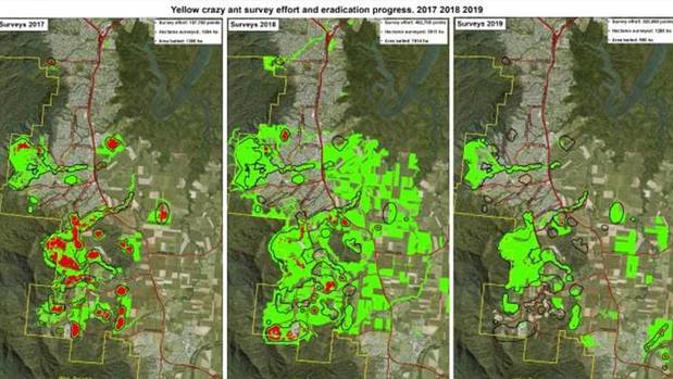
It's a problem so intense it's left Australians and their pets blind, caused them horrific burns and forced them to abandon their homes, news.com.au reported.
Welcome to Australian's $9.2 million yellow crazy ant problem, as vicious infestations of the invasive pest sweep far north Queensland, wiping out wildlife and infrastructure in their wake.
In one of the worst cases of infestation, farmer Frank Teodo had so many of the terrifying species teeming through his house they eventually fell from the light fittings and blinded him after spraying their formic acid in his eyes.
Queenslanders have had to get rid of their pets because of fears the ants will spray their dogs, which have been left with facial burns after getting their noses into nests.
"I've seen TVs blown up, toasters, microwaves and airconditioning units because they get in and short-circuit them," says Gareth Humphreys, senior technical officer with the Yellow Crazy Ant Eradication program run by the Wet Tropics Management Authority (WTMA).
"I've seen the ground literally moving so much that when you look down you can't focus properly.
"You just don't understand how you can get such a high density of ants.
"I've seen people move who say we know you're doing your best (to get rid of them) but we just can't live like this anymore. It's pretty extreme stuff when someone sells their home and moves."
/arc-anglerfish-syd-prod-nzme.s3.amazonaws.com/public/4QJCJRXRRBFFVD7XSPRNGTL7MI.jpg)
The issue has plagued the region so intensely that in the recent Federal Budget the Government allocated $9.2 million to eradicating the pests.
The Government is also spending $18.3 million to help eradicate red fire ants, and Norfolk Island will get an extra $8.4 million, part of which will be used to "significantly advance the response to the biosecurity threat of Argentine ants".
There are five ant species among the 100 most invasive outlined by the International Union for Conservation of Nature, all of which are found in Australia.
The list also includes the electric ant and the African big-headed ant.
"They can actually do some severe damage," says Dr Lori Lach, associate professor at James Cook University who's been monitoring yellow crazy ants since the eradication program started in 2013.
The wet tropics region was "boiling with ants" back then but the program has made significant progress in controlling the pests and giving locals back their livelihood.
Of the 25 sites being monitored near the Cairns region, eradication has been declared at three sites.
But Dr Lach warns there's still a long way to go.
"One of the things people don't understand is you don't treat and go, 'They're not there' and you're done," she says.
"To have confidence they're not there you need to look many times and you need checks in between that."
Sites have to be checked at six-month intervals to make sure they're completely free of the pest, which somehow made its way to Australia and infiltrated up to 1700ha of land.
/arc-anglerfish-syd-prod-nzme.s3.amazonaws.com/public/GKOEXPGGH5GKHLMIEU7ULAFCAA.jpg)
Technical officers set lures with a mixture of cat food and jam because the ants are attracted to sugar and carbohydrates.
The ants get the name "crazy" because of how they move.
"Most people think of ants following a nice trail but these ones just forage everywhere," Dr Lach says.
"They're really amazing creatures. You never see them in a trail, they'll be running all over — that's why they're crazy.
"They're not picky about where they nest — they can nest in a Coke can, under a palm frond. In a Telstra box I've never seen a nest so big, there were so many queens."
Dr Lach says the all-female super colonies that have few males multiply because they don't operate like normal ants.
"With most ant species they're very territorial," she says.
"They'll have wars against adjoining colonies. Yellow crazy ants don't do that. They're not expending resources fighting each other so they're not dying off."
While $9.2 million seems like a lot of taxpayer money, WTMA chair Leslie Shirreffs warns the cost of not doing anything would be astronomical.
Over the next 30 years, the eradication program's net environmental and socio-economic value is said to be $6.1 billion.
"Before this program started this area was boiling with ants. They were everywhere. They were just like a moving feast," she tells news.com.au.
The WTMA works to protect the World Heritage Area, nearly 900,000ha of land with a rich diversity of plants and animals, 700 of which are found nowhere else in the world.
Take your Radio, Podcasts and Music with you









